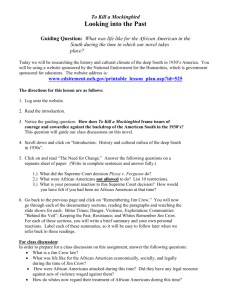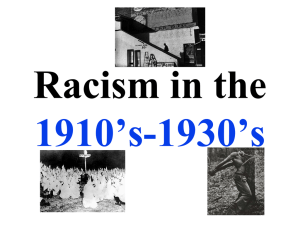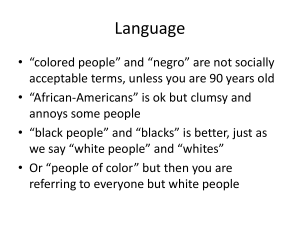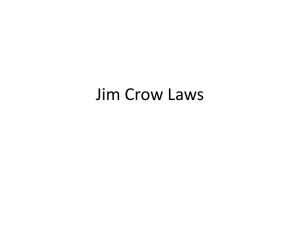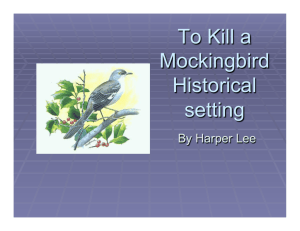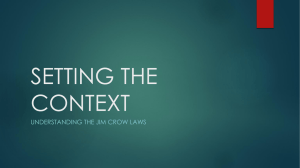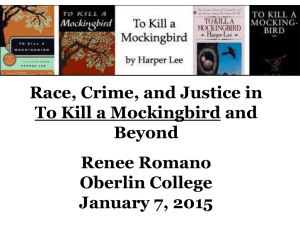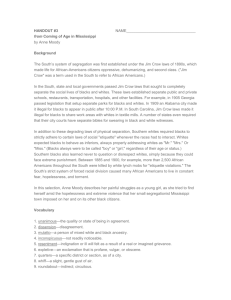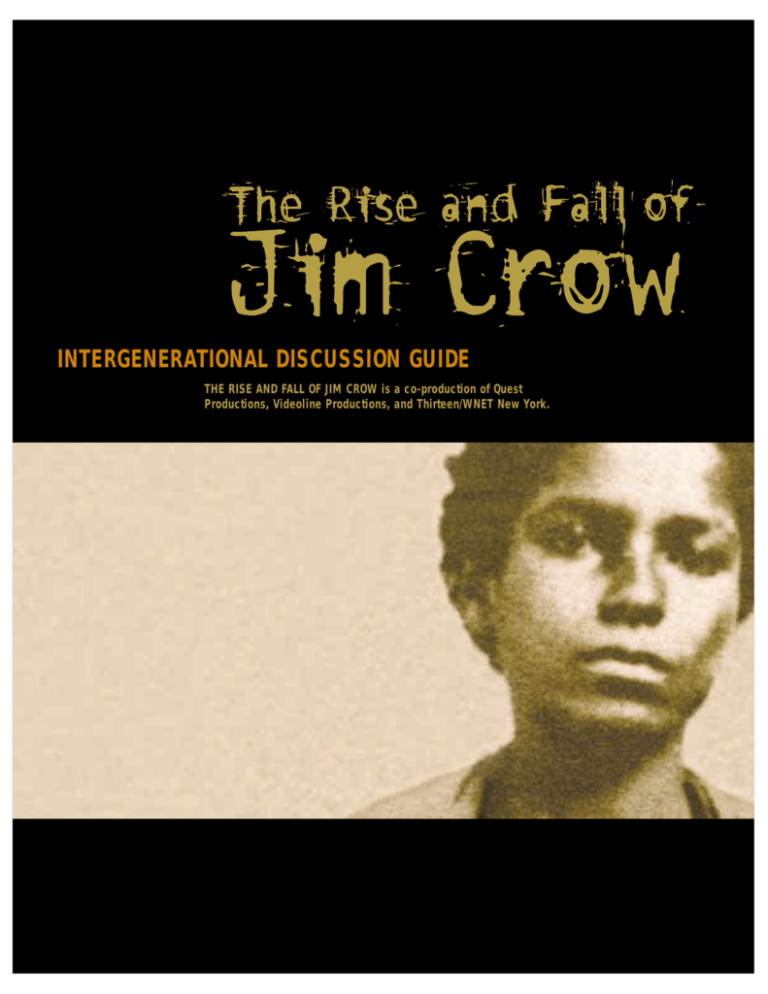
INTERGENERATIONAL DISCUSSION GUIDE
THE RISE AND FALL OF JIM CROW is a co-production of Quest
Productions, Videoline Productions, and Thirteen/WNET New York.
DEAR READER,
TABLE OF CONTENTS
PAGE 1
Conducting
an Oral History
Interview
PAGE 2
Program One:
Promises Betrayed
PAGE 4
Program Two:
Fighting Back
PAGE 6
Program Three:
Don’t Shout
Too Soon
PAGE 8
Program Four:
Terror and Triumph
I
consider myself as someone whose political and social awakening
took place during the Civil Rights movement of the 1960s. As a foot
soldier in a grand army on the march for humanity, I became aware that
the struggle against Jim Crow that many of us were experiencing for the
first time had been ongoing in the African American community for
generations.
At that time, I was just beginning my career as a filmmaker. The complexity and richness of telling the Jim Crow story was far beyond my
grasp. But as I learned my craft and began to make films, I continued to
think about the 1960s — and the passions that informed that movement.
In 1992, I finally came up with the solution that had eluded me for so
long — let African Americans tell the story of their own struggles themselves. And out of that shock of recognition came The Rise and Fall of
Jim Crow.
I have been asked why is it so important to tell the story of Jim Crow.
Because, in my judgment, the Jim Crow years are the crucible in which
modern day race relations have been formed. You cannot understand
BACK FLAP
Family &
Community
Projects
BACK COVER
Resources &
Organizations
why we continue to have racial difficulties without understanding this
period of our history. Jim Crow is an American story, not just an African
American story. It is a shared history for all of us. It is part of my legacy
as a white person, as it is part of the legacy of black people.
Jim Crow is also a story that young people should know because young
people need heroes, and they need to develop a moral sensibility. The Jim
Crow story provides both and thus is needed by youth, especially in
today’s materialistic world.
ABOUT THIS GUIDE
The Rise and Fall of Jim Crow Intergenerational Discussion Guide has been devel-
BROADCAST SCHEDULE
The Rise and Fall of Jim Crow is scheduled
to air on the following dates:
Tuesday, October 1, 10 p.m. ; Tuesday, October 8, 10 p.m.
Tuesday, October 15, 10 p.m. ; Tuesday, October 22, 10 p.m.
For specific broadcast information, visit our Web site at:
pbs.org/jimcrow or contact your local PBS station.
oped to encourage communication between generations about the history and
impact of the Jim Crow era. The guide’s four sections include program descriptions, original essays, personal accounts, and compelling side bars. Each section
offers questions that can be used to stimulate discussion. The art and music projects at the end of the guide will stimulate creative expression. A research activity offers readers the opportunity to explore the history of Jim Crow in their own
communities. Finally, there are resources and a list of organizations that can help
facilitate discussions about race and prejudice.
This guide may be photocopied and distributed to educational organizations,
community groups, teachers, and individual viewers. To request a Guide, please
write to: Jim Crow Guide, P.O. Box 245, Little Falls, NJ 07424-0245 or email us
at guiderequest@thirteen.org.
Copyright ©2002 by Educational Broadcasting Corporation. All Rights Reserved
00
Conducting an
Oral History Interview
SEVERAL PROJECTS IN THIS GUIDE REQUIRE TAKING AN ORAL HISTORY.
Oral histories collect people’s memories and personal commentaries through interviews recorded in
audio or video format. The interviewee may be a family member, neighbor, civic leader, or some other
individual who lived through a momentous period in history. You can make the oral history interview
more useful for yourself or for a wider audience by following these recommendations:
1. Consider who will want to view
and use the oral history. You may be
the only one to conduct an interview with
this person. Broaden the scope of your
questions as much as possible.
2. Prepare for the interview by
researching the period in which the
interviewee lived (e.g. where he or she
worked or worshipped). Learn about the
papers, photo albums, office files, etc. Ask
the interviewee to recommend things for
you to consult.
3. Use the best equipment possible,
especially good microphones and
high-quality tapes. Know how to operate
the video camera or tape recorder and
microphones. Bring extra tapes and batteries. Position the equipment unobtrusively,
but close enough to you so that you can
monitor it. You don’t want the tape to run
out in the middle of the dialogue!
UNIVERSITY OF OREGON LIBRARY SPECIAL COLLECTION
4. Ask open-ended questions, not
those that can be answered with a
simple “yes” or “no.” Listen carefully
to the interviewee’s answers and do not
interrupt. Bring a list of prepared questions
but be ready to respond to and discuss
issues you had not anticipated. Never be
afraid to admit that you did not know
something or to ask for clarification.
5. If possible, interview the person
more than once. This will enable you to
build trust and confidence toward a more
candid interview. Try to cover topics in
chronological order, starting with the earliest events and moving forward. But keep in
mind that people’s minds do not always
work so neatly. Talking about later events
may trigger memories of earlier times.
specific people and events you expect to
cover. Be creative in your research: Use
newspapers, history textbooks, family
6. Budget your time and funds
wisely. Don’t spend all your resources
conducting a series of interviews and then
run out of funds before processing
the tapes.
7. Document and archive the interviews. Transcribe the tapes when possible,
or at least write a detailed summary of the
topics covered. Preserve the tapes and
transcripts under optimal conditions —
ideally by donating them to a library or
archives. You might also post the interviews
on the Internet.
8. Establish copyright for the interviews. This will permit the interview to be
published or used for research in the future.
An interviewee owns his or her words until
he or she has signed a deed or gift, giving
the copyright to the interviewer, a library or
the public domain.
9. Review your interviewing style to
improve your technique. Listen to your
tapes and think about the way you asked
questions and about the questions you
could have asked. Don’t be discouraged by
“glitches.” Oral history is incremental, and
interviewers can learn from their mistakes.
Consult the Oral History Association’s
Evaluation Guidelines at
www.dickinson.edu/oha/ .
10. Share the results with the interviewee. Offer free copies of the tape and
transcript to the interviewee. Let him or her
know how the interviews will be used and
invite him or her to any public presentation
of the materials.
Donald A. Ritchie, Senate Historical Office
Author of “Doing Oral History”
1
PROGRAM ONE:
Promises Betrayed (1865–1896)
Crow years, African Americans were passionate
about education. Many men and women learned
to read despite the risks involved. A slave caught
reading could be whipped or branded. A freedman caught teaching other blacks could be re-enslaved or
killed. After the Civil War, former abolitionists who came
south to open schools found many freedmen and women
defiantly building and maintaining their
Program Summar y
own schools.
Following the Civil War, whites denied
African Americans their dreams of owning land and obtaining their political
and civil rights.Whites subjected blacks
to disfranchisement and segregation
enforced by law, as well as lynchings,
beatings and burnings. African
Americans responded by creating opportunities for themselves — politically, economically and educationally. Booker T.
Washington founded Tuskegee Institute;
Ida B.Wells confronted segregation in
Tennessee; and Isaiah Montgomery built
the successful all-black town of Mount
Bayou in Mississippi. In 1896, the
Supreme Court, in the case of Plessy v.
Ferguson, upheld the pernicious doctrine
of “separate but equal.”
PHOTO CREDITS
When the Jim Crow era began in the
1880s, Southern whites adamantly
opposed anything but minimal education for black children. White planters
felt that education spoiled “good field
hands.” Urban whites felt that education made blacks “too uppity.” By the
end of the 19th century, almost twothirds of black children could not
attend school because they had neither
school buildings nor teachers. Whites
often burned down black schools and
killed or drove teachers out of the community. In spite of all this blacks were
not deterred.
The black community supported
their own schools; and local churches
often provided education through
Sabbath schools. Over 70 percent of all
black children in school attended private schools.Whenever
blacks could influence state legislators, they asked that all
children have access to public schools. Missionary societies
from the North founded black colleges and training schools,
such as Fisk, Atlanta University and Hampton, which produced future black leaders. Booker T. Washington attended
Hampton in the 1870s. A decade later,W.E.B. Du Bois grad-
2
uated from Fisk.
In the 1880s, when Booker T. Washington founded
Tuskegee Institute, whites supported his efforts because they
thought the school would accommodate white supremacy by
training its students for labor. Yet, for many young people,
Tuskegee was a godsend. After receiving a Tuskegee education,William Holtzclaw founded Utica College in Mississippi.
While some schools offered vocational education to get
much needed white financial support, others “trained minds
instead of hands.” Lucy Laney, Charlotte Hawkins Brown and
other teachers saw education as a means of “uplifting the
race.” Modeled on New England Colleges, Fisk and Atlanta
taught their students academic subjects, aiming to produce
“race leaders, not followers.” W.E.B. Du Bois declared that
the mission of quality schools was to train the “Talented
Tenth,” the ten percent of the black community that would
lead the rest out of the snare of Jim Crow and into freedom.
He was right. Many of the leaders and soldiers of the Civil
Rights movement were students from black colleges. ■
Essay by Richard Wormser, the producer and episode writer/director of The Rise and Fall of Jim Crow.
Children hard at work in the schoolhouse.
00
TOP: UNC CHAPEL HILL, NORTH CAROLINA COLLECTION; BOTTOM: NATIONAL ARCHIVES
F
ROM THE DAYS OF SLAVERY THROUGH THE JIM
Black men collecting cotton
in the rural agricultural
post-slavery South.
“She would hide me behind skillets, ovens and pots.
Then she would slip me to school the back way...”
DOOMED TO A LIFE OF SHARECROPPING IN Alabama in the 1880s, Addie and Jerry Holtzclaw
passionately believed that with an education their children could escape the same fate. The
Holtzclaws and fellow sharecroppers built a school and hired a teacher. The landlord wanted
ed Cobb, a tenant farmer in Alabama,
the children to pick cotton, but Addie “outfoxed him.” William Holtzclaw remembered: “She
grew up during the height of Jim Crow.
would hide me behind skillets, ovens and pots. Then she would slip me to school the back
He recounted his life story to Theodore
way, pushing me through the woods and underbrush until it was safe for me to travel alone.”
N
Rosengartern, whose book, All God’s Dangers,
won the National Book Award:
When the boys got older, they had to work, but Addie arranged for them to get some educa-
“My children weren’t going to school worth noth-
tion. “One day I plowed and he went to school.” William Holtzclaw recalled. “The next day he
ing then. It weren’t their fault, they wanted to go
plowed and I went to school. What he learned during the day, he taught me at night and I did
and it weren’t my fault. I wouldn’t of stopped
the same for him.”
them from going. The school for colored children
up yonder, it’s run two or three weeks, maybe a
William desired a richer education, so he wrote to Booker T. Washington, the head of
month and a half on the outside and the word
Tuskegee Institute: “Dear Book, I wants to go to Tuskegee to get an ejercashun. Can I
come down … ‘cut the school out. Money’s
come?” “Come,” Washington replied. Tuskegee transformed William Holtzclaw and
gone’.… The money was comin’ here through
enabled him to open his own school — Utica College in Mississippi.
white hands and they was concerned with keeping colored children out of school.... We was
always left to wondering whether we would have
any schools or not. White man could go up
there and hire the colored children from their
Champion
of education,
Charlotte
Hawkins Brown.
parents, nothing said. . . . Poor fellows, at home,
cut loose from their books. White man come up
there cotton choppin’ time in May . . . chaps
couldn’t go to school, the school was closed
down on them, . . . — better let ‘em work for
him; don’t they’ll get mad with you and it’ll hurt
Discussion
Questions
you one way or another.”
All God’s Dangers: The Life of Nate Shaw
by Theodore Rosengarten, Jeff Stone, Nate Shaw
NORTH CAROLINA DEPT. OF ARCHIVES AND HISTORY, RALEIGH, NC
Personal Account
The experience of a whole race beginning to go to school for the first time presents one of the most
interesting studies that has ever occurred with the development of any race. Few people who were
not right in the midst of the scenes can form any idea of the intense desire, which the people of my
race showed for an education. As I have stated, it was a whole race trying to go to school. Few
were too young and none too old to attempt to learn. As fast as any kinds of teachers could be
secured, not only were the day schools filled but the night schools as well.The great ambition of
the older people was trying to learn the Bible before they died.With this end in view, men and
women who were sixty and seventy years old would be found in the night school. Sunday schools
were formed soon after freedom but the principal book studied in the Sunday school was the spelling
book. Day school, night school, Sunday school, were always crowded and often many would have
to be turned away for lack of room.
Booker T.Washington
■ In the Jim Crow era, African Americans
attended segregated schools because they
had no choice. Today, some African
Americans argue that all-black schools are
better for black students. What’s your
opinion?
■ Do you think that black and white
students today have equal educational
opportunities? What evidence do you have
that supports your belief?
■ Do you think that colleges should take
race or ethnicity into consideration in their
admission policies? Why or why not?
3
PROGRAM TWO:
Fighting Back (1896–1917)
W
HEN GENERAL
O. O. Howard
visited
the
W a l t o n
Spring School
for formerly enslaved students in
Atlanta, he asked a class what message they had for the children of the
North. One student, Richard R.
Wright, proudly answered: “Tell
them we are rising!”
From the end of the Civil War
through Reconstruction to the end
of the Jim Crow era, African
Americans continued to rise.
Wright himself became a bank
president. Although whites tried
to thwart any black progress
during the Jim Crow era, they
failed to do so.
Program Summar y
Black businessDenied their rights, blacks created their
men believed
own churches, schools, businesses, and
that through
clubs. In Wilmington, North Carolina,
economic
a successful black middle class became
uplift,
racial
the target of rioters in a white
solidarity and
loyalty
to A 19th century photograph of customers frequenting a black-owned pharmacy.
supremacist political campaign. African
America, African
Americans persisted. Charlotte
Americans would triumph over segre- women teachers than men.
Hawkins Brown built quality schools
gation. Booker T. Washington advised
while black musicians created the blues
his black audience they could prove
Black bourgeois families mirrored the Victorian model,
and jazz.The black community in
their worthiness as Americans by suc- which stressed monogamy, chastity, hard work, thrift, godliAtlanta, Georgia, maintained five
ceeding economically. “There was ness, cleanliness, and patriarchal rule. But if black profescolleges despite a violent riot in 1906.
room at the top,” he said. As the New sionals identified with their white counterparts, whites did
In 1910,W.E.B. Du Bois left Atlanta
York Age expressed it, “The almighty not reciprocate. Middle class whites felt more in common
to join the newly founded National
dollar is the magic wand that knocks with “poor whites,” whom they generally loathed, than with
Association for the Advancement of
the bottom out of race prejudice.”
middle class blacks.
Black businesses catered to the white
community during the 1880’s, but as
Jim Crow intensified, they served only
the black community. Men and women
like George Merrick, C.C. Spaulding, Minnie Cox, and
Alonzo Herndon built successful life insurance companies.
Frank Church became a real estate magnate, Maggie Walker a
banker. Others founded successful funeral homes, barber
shops, saloons, livery stables, and construction companies.
PHOTO CREDITS
Few professions or white-collar jobs were available to
black women. Some worked in churches and women’s
clubs. The one profession that was open to them was
teaching. By the turn of the century, there were more
4
Most middle class blacks subscribed to a doctrine of racial
uplift — especially when it came to the working class poor.
Black women dedicated their energies to improving the life
of poor people. While racial uplift provided needed help, it
also served to divide the black community between middle
class and working class.
Despite numerous obstacles, the black middle class played
a major role in providing leadership for the black community. It provided numerous leaders for the Civil Rights movement of the 1960’s, including Dr. Martin Luther King, Jr. ■
LIBRARY OF CONGRESS
Colored People (NAACP), an interracial civil rights organization. Dr. Du
Bois fought for black rights and against
segregation in the federal government.
Essay by Richard Wormser, the producer and episode writer/director of The Rise and Fall of Jim Crow.
00
T
he following is an excerpt from The Philosophy and Opinions of Marcus Garvey. Garvey was a charis-
matic black leader who formed the Universal Negro Improvement Association (UNIA) in the early
twentieth century, hoping to organize a massive emigration of blacks back to Africa. His goal was
to uplift the race.
“Lift up yourselves men, take
yourselves out of the mire and hitch
your hope to the stars; yes, rise as
high as the stars themselves.”
When we come to consider the history of man, was
not the Negro a power, was he not great once? Yes,
honest students of history can recall the day when
Egypt, Ethiopia and Timbuktu towered in their civilizations, towered above Europe, towered above
Asia.… Why then should we lose hope? Black men,
you were once great, you shall be great again. Lose
not courage, lose not faith, go forward. The thing to do is get organized: keep separated and you will be
exploited, you will be robbed, you will be killed. Get organized and you will compel the world to respect
you.… Lift up yourselves men, take yourselves out of the mire and hitch your hope to the stars; yes, rise
as high as the stars themselves.
Left: Portrait
of the Sadgwar
family, prominent
members of the
Wilmington
middle class.
Right: A young
girl receives
piano lessons
from a black
piano teacher.
Discussion
Questions
LEFT: NEW HANOVER COUNTY PUBLIC LIBRARY; RIGHT: LIBRARY OF CONGRESS
■ When the black middle class emerged
after the end of slavery, it began to distinguish itself from the working class. Do you
think that class distinctions still exist today
within the African American community?
■ Do you think that black businessmen
and women today have a relatively equal
chance of succeeding? Do you know any
black businesspeople who have done so?
How did they succeed?
■ Do you think that those who have succeeded in the African American community have any responsibility to those who
have not been as fortunate?
Why or why not?
Personal Account
The success of the black middle class and its attempts to win political power infuriated
many whites. They saw it as an attempt by blacks to get out of “their place.” In 1898, a
race riot occurred in Wilmington, North Carolina. Middle class blacks were one of the main
targets. The following quote is an eye-witness account of the riots by Reverend Alan Kirk,
a black minister.
Firing began and it seemed like a mighty battle in wartime.They went on firing it seemed at
every living Negro, poured volleys into fleeing men like sportsmen firing at rabbits in an open
field; the shrieks and screams of children, of mothers and wives, caused the blood of the most
inhuman person to creep; men lay on the street dead and dying while members of their race
walked by unable to do them any good.
5 00
PROGRAM THREE:
Don’t Shout Too Soon (1918–1940)
T
against lynching, in the efforts of black sharecroppers to
organize, and in the pioneering legal work of Charles
Hamilton Houston.
Whites mounted fierce resistance to any changes in the
racial status quo, and tensions exploded in race riots
and lynchings during 1919 — a reign of terror that
suppressed many
In 1934, at the height of the Depression, Charles Hamilton
Houston became general counsel for the NAACP. With
Marshall working as his assistant, Houston tapped into the
HE RETURN OF BLACK SOLDIERS FROM
overseas at the end of World War I fueled a
heightened determination among blacks,
North and South, to secure the promise of
democracy. Nearly a quarter of a million
black soldiers had fought on the battlefields of Europe.Their
experience led to the “New Negro” movement of the postwar era. A local NAACP leader in Austin, Texas, reported,
“They have returned to old homes but they are not going to
submit to old ways.”
Houston, a veteran of World War I, came back from the
war committed to studying law and “fighting for those who
could not fight back.” After completing his law degree at
Harvard Law School, he joined the faculty at Howard
University Law School, where he trained a generation of
civil rights lawyers, among them Thurgood Marshall.
Program Summar y
PHOTO CREDITS
of the promising
efforts that came
out of the war.
Black American soldiers dance with French women, breaking a strictly upheld taboo in America.
But
thethespirit
But
spiritofof
the New Negro endured. It nurtured an outpouring of cul- rising expectations stirred by the New Deal and launched a
tural, literary and musical creativity that flowered in the concerted campaign to dismantle Jim Crow laws. Houston
Harlem Renaissance, in the works of people like Langston and Marshall traveled thousands of miles throughout the
Hughes, Claude McKay, Zora Neale Hurston, Sterling South, enlisting blacks in a struggle that would be played out
Brown, and Aaron Douglas. It also found expression in in communities, at the polling booths and in courtrooms —
Marcus Garvey and his United Negro Improvement quietly laying the groundwork for the Civil Rights moveAssociation, the largest mass black organization in the United ment of the post World War II decades. ■
States, which celebrated racial pride and promoted black
economic development. Scattered protests continued into Essay by Patricia Sullivan, author of Days of Hope: Race and
the Depression era, on black campuses, in the campaign Democracy in the New Deal Era.
6
00
CORBIS
African American soldiers returning
home after World War I faced an epidemic of race riots while the NAACP
expanded an anti-lynching campaign.
When the white president of Fisk
University accommodated the Jim Crow
views of influential white funders, black
students forced his removal with a
strike. Hundreds of thousands of blacks
left the South, including musicians and
writers who gave birth to the Harlem
Renaissance. In the cotton fields, sharecroppers, aided by Communist organizers, began to oppose their landlords.The
NAACP, now led by Walter White and
Charles Hamilton Houston, began to
challenge Jim Crow in the courts.
Houston’s strategies would become the
basis for the final assault against
Jim Crow 20 years later.
Left: Flag flown at NAACP’s New York headquarters.
Right: Harlem Renaissance artist Aaron Douglas working at easel.
Discussion
Questions
■ W.E.B. Du Bois looked to the “Talented
Tenth” to provide leadership in the struggle
for black liberation and civil rights. Why do
you agree or disagree with this? Is this an
elitist concept?
“It was a great shock . . . and made
many people face up to a situation.”
n the spring of 1931, nine young black men were charged with raping two white
I
women near Scottsboro, Alabama. They were quickly tried amid a mob atmosphere
and sentenced to death. Charles Hamilton Houston called it a “judicial lynching.”
■ In 1934, Du Bois argued that the inter-
The International Legal Defense, the legal arm of the American Communist
ests of black students would be best
served in separate schools, sparking a
spirited debate within the NAACP. What
factors led Du Bois to this conclusion?
What relevance, if any, does this debate
have today?
Party, secured new trials and mounted mass protests demanding that the
“Scottsboro Boys” be freed. It would be years before all of the men were
released from prison. But their lives were spared, and the publicity surrounding the case revealed the harsh realities of segregation. A contemporary compared it to the dramatic impact of the police assault on
protesters in Birmingham in 1963: “It was a great shock . . . and made
■ With the normal channels of political
TOP: LIBRARY OF CONGRESS; AARON DOUGLAS PORTRAIT COLLECTION; LIBRARY OF CONGRESS
participation closed to African Americans
in the South in the 1930s, Charles
Hamilton Houston envisioned the black
lawyer as “a social engineer,” as one who
would “anticipate, guide, and interpret his
group’s advancement.” How successful
was Houston in realizing this ideal?
many people face up to a situation.”
W.E.B. Du Bois.
For Houston, the Scottsboro case represented a pivotal event in the development of
black protest. All who joined in the fight, Houston wrote, “were made to feel that even
without the ordinary weapons of democracy . . . [they] still had the force . . . with which
they themselves could bring to bear pressures and effect the result of the trial and arbitrations.” It would be remembered, he said, as “a milestone” in American history.
Personal Account Walter White on Election Terror in Florida, New Republic, Jan. 12, 1921
The recent election brought into full play all of the fear that “white supremacy” would crumble if Negroes were allowed to vote, augmented by the
belief that the recent war experiences of the Negro soldier had made him less tractable than before. In many southern cities and towns, parades of
the Klan were extensively advertised in advance and held on . . . the Saturday before the election. . . .Today, the Negro is neither so poor nor so
ignorant nor so easily terrified [as in the days after Emancipation], a fact known by everybody but the revivers of the Ku Klux Klan. Instead of
running for cover, frightened, his mood now is to protect himself and his family by fighting to the death.
This can best be shown by the attitude of the Negroes of Jacksonville [Florida]. An old colored woman, standing on Bay Street as she watched
the parade of Klansman on the Saturday night before the election, called out derisively to the marchers:
“Buckra [poor white people], you ain’t done nothing.Those German guns didn’t scare us and we know white robes won’t do it now.”
. . .Whatever the intentions of the sponsors of the parade, it acted as an incentive to bring to the polls on Election Day men and women voters
who had before been indifferent....
7 00
PROGRAM FOUR:
Terror and Triumph (1940–1954)
1971 IN A CENTRAL ALABAtown where I had gone to interview a former
cotton farmer by the name of Ned Cobb. Forty
years earlier, Cobb had belonged to a militant organization called the Sharecroppers Union. He spent
twelve years in prison for his part in a shoot-out with the
sheriff ’s deputies who tried to take
away his neighbor’s livestock for nonProgram Summar y
payment of debt. Mornings I would sit
Returning home from military service in
with Cobb on the veranda of his tool
World War II, African Americans like
shed as he whittled strips of live oak
Charles and Medgar Evers were unwilland answered my questions about the
ing to resume life in segregated America.
past. Afternoons I would cool off in a
With a Supreme Court decision making
nearby lake — the municipal pool had
all-white political primaries illegal,
been drained years before and filled
blacks like John Wesley Dobbs in
with concrete so that white and black
Georgia organized voter registration
children would not swim together.
drives. President Harry Truman involved
Evenings, I coached a baseball team in
the federal government in civil rights
the local Dixie Youth League — an
issues for the first time since
organization founded in 1954 when
Reconstruction. A student strike orgathe national office of the Little League
nized by Barbara Johns against unequal
ordered its state branches to integrate.
schools in Farmville,Virginia, became
Now Dixie Youth was defying its orione of five cases that the U.S. Supreme
gins as the walls of separation came
Court reviewed when it ruled segregatumbling down around the baseball
tion unconstitutional in
diamonds of the rural South. “Once
you play ball with them,” the father of
May of 1954 in
my first baseman confided, as his son’s
Brown v. Board of Education.
black teammates climbed into the back
of his pick-up after a game, “you don’t
want to play without them.”
out of the same boat or to sit at the table and play cards or
checkers? What interest was served by requiring black and
white witnesses to swear on different Bibles? Were whites
and blacks who worked in cotton mills really expected to
obey a law that forbade them from looking out of the same
window? The minutia of Jim Crow may strike us today as
comical, but its intent was deadly serious.
People accommodated quickly to the new order, so why
had Jim Crow ruled for so long? Why had the southern
states deemed it a crime for white and black people to fish
Essay by Theodore Rosengarten, author of All God’s Dangers:
The Life of Nate Shaw and TOMBEE: Portrait of a Cotton
Planter.
SPENT THE SUMMER OF
PHOTO CREDITS
MA
8
Black GI’s returning from World War II expected to find
things changed when they got home but were bitterly disappointed. They had fought like men, but whites persisted in
calling them “boy.” Their uniforms and medals were met
with derision. They still had to tip their hats, step aside in the
streets, sit at the back of the bus, and make way for whites at
intersections. But while they were fighting to free Europe of
Hitler, black GI’s had re-imagined their place in a democratic society. The ones who returned to fight inequality and
discrimination battled in virtual anonymity in the era before
television.
Time, which had appeared to stand still in the era of the
mule and plow, was now on the side of the downtrodden.
The defeat of Nazism had discredited the doctrine of “scientific racism,” and the nation was less willing to accept a
southern solution to the race question. In a historic turnabout, Harry S.Truman, a president from the border state of
Missouri, declared that the federal government stood with
Americans who aspired to equal rights. The courts became
platforms for challenging the status quo. The law was beginning to side with the disfranchised. Black protest rose rapidly to revolution. ■
00
SCHOMBURG CENTER-NYPL
I
A black American
soldier with captured Nazis in
Germany, 1945.
contend that the Negro is the creative voice of America, is creative
America, and it was a happy day in America when the first unhappy slave
was landed on its shores. There, in our tortured induction into this “land
of liberty,” we built its most graceful civilization. Its wealth, its flowering
fields, its handsome homes, its pretty traditions, its guarded leisure, and its
music were all our creations. . . .
I
It is our voice that sang “America” when America grew too lazy, satisfied and
confident to sing, before the dark threats and fire-lined clouds of destruction
frightened it into a thin, panicky quaver.
Mrs. Nettie Hunt with her daughter Nickie on the steps of the U.S.
Supreme Court, after the Brown vs. Board desegregation ruling.
“It is our voice that sang ‘America’ when America
grew too lazy, satisfied and confident to sing....”
We are more than a few isolated instances of
courage, valor, achievement. We’re the injection,
the shot in the arm that has kept America and its
gotten principles alive in the fat and corrupt years intervening between our
divine conception and our near-tragic present.
Edward Kennedy “Duke” Ellington, 1941
Left: Blacks exercise their right to vote.
Right: A mock lynching.
Discussion
Questions
■ Opposition to Jim Crow was not confined
to the North and not confined to black people either. Many white southerners hated
segregation but did not speak out, yet tried
in private to treat all people with dignity.
What circumstances in your life keep you
from protesting injustice? Do you feel
responsible for correcting conditions that
may stem from past social practices?
TOP: UPI/CORBIS; BOTOM LEFT: LIBRARY OF CONGRESS;
BOTTOM: RIGHT STETSON KENNEDY
PHOTO
CREDITS
■ Are there circumstances under
which you could justify joining a sorority,
fraternity, or social club that openly discouraged membership by blacks, Jews,
or any other group?
“It was in the state of Georgia, in 1946, that a young Negro veteran named Maceo Snipes learned
that by Supreme Court ruling he had a right to vote. No Negro had voted in his county since
Reconstruction, but Maceo Snipes went down and registered. The following morning he was sitting on his porch and a white man came up and killed him with a shotgun. His funeral was held
the next day and in the midst of the funeral oration, Maceo’s mother rose and moved up through
the crowd, up to his coffin, where they waited to lower it into the earth. And she asked her second son to come forth. He was 17. And she said to him, ‘Put your hand on this coffin, and swear
on the body of your brother than when you get to be 21, you’re going down to the courthouse to
do what he did — to vote.’ ”
Henry Wallace
Progressive Party Candidate for President
“Radio Address,” September, 1948
■ How would you respond to the argument
that segregation created more opportunities
for blacks than integration, because separate black institutions employed more
principals and teachers, for example, in
schools set aside for blacks, than did
racially mixed schools?
■ Does the display of the Confederate battle flag bother you? Construct an argument
in favor of taking the flag down or leaving it
up on the dome of a state capitol building.
■ What passages from the books of your
religious tradition would you cite to support
your position on the role that race should
play in modern life?
9
00
THE PROJECT: ORAL HISTORY
Prepare a set of questions that will guide
your investigation. In addition to your own
questions you can use the following:
Did your community or city once
go by a different name or nickname?
What were the neighborhoods called?
Can you link these names to Jim Crow
practices?
■ Were there segregation laws and
practices in existence that enforced
Jim Crow in social, educational or
economic settings? What were these
laws? Who signed them into local
legislation?
■
Was there any resistance
from blacks or whites?
Were there heroes who spoke
or acted out against the laws
and practices?
■ How large was the community?
Try to find demographic information
for neighborhood populations.
■ Were there lynchings?
■ What do the voting records
indicate about black suffrage?
■
WRAP-UP
THE PROJECT: LISTENING
In the following group activity, you are
invited to share a selection of music
from any genre composed and performed by African American musicians
that you think illuminates your understanding of Jim Crow and the color
line in America. To the degree possible, your group should include people
of diverse backgrounds.
Each participant brings a song that
he or she would like the group to
listen to and discuss. For each song:
Briefly introduce the song: artist,
title, genre, and year it was recorded
and released.
Play the song.
Explain why the song has meaning for
you: how the song evokes memories
of Jim Crow for older participants,
how the song comments on contemporary race relations, how the song
helped you emotionally or spiritually,
how it shaped your thoughts on segregation or the black experience.
Open the discussion up to the group
with inviting questions, or perhaps the
group has already jumped in. How or
what does the song communicate
across generations? Does its meaning
change for people of different ages
and races? If an older song, does it
have a political or social message for
today’s younger generation? If a new
song, does it move the older generation or put them off?
WRAP-UP
You will need to organize, analyze and interpret the information you
gather. Information should be presented to neighbors, family members
and community representatives. Display charts, tables and brief reports
to summarize your community investigation. Include topics such as
community history, leadership and resistance movements. Request written or oral feedback from community members.
After concluding the listening session, your group may consider the
following activities:
1. Organize a community concert that features local musicians or
participants from the listening session.
2. Have each member of the group write lyrics to a song that looks at
race relations in present day America. Share the lyrics with the group.
THE PROJECT: QUILTING
THE PROJECT: MURAL
Before beginning, look over directions
for sewing quilts and view some examples from the web and book resources
listed below. It is recommended that
your quilting group include members
who are of different ages and races.
Elders and youth can work together to
create their own Intergenerational
quilt. Each panel of the quilt will
depict a scene or symbol that represents Jim Crow’s suppression of
African Americans or one of the many
ways blacks and whites challenged
segregation laws and triumphed over
Jim Crow. Scenes and symbols might
include voter registration cards,
blacks riding in the front of a bus, Jim
Crow signage indicating segregated
facilities, black students reading
books in school, sharecroppers toiling
in the fields, activists marching or
protesting, headlines from famous
events, or court decisions. What symbols can participants come up with?
Your group should sit down to decide
what each panel will show and who
will sew it. Create the scenes and
symbols with fabrics, felt letters and
small mementos. To include photographs or text, photocopy them onto
iron-on transfers, and iron them onto
100% cotton fabric.
Mural Content: With your group, paint
a mural that depicts an important
historical event in the struggle against
Jim Crow. To learn more about race
relations in your community in the Jim
Crow era, have each member conduct
an oral history interview. (See the Oral
History section of this guide.)
After completing the interviews,
discuss your tapes and videos.
Decide which local events (or national
events shown in the Jim Crow series)
you would like to commemorate.
Conduct additional research to gather
background information in preparing
for your initial sketches.
Location: If you don’t already have
a location in mind, you will have to
scout out a large open wall for your
mural. You must get permission
from the property owner to paint your
mural. If a permanent location is not
possible, use a large canvas or sheet
of heavy paper and display it.
Mural Form: Decide how the group
would like to illustrate these historical
events. The mural could be a single
large panel or a series of three or
four panels showing related events.
Draw preliminary sketches and an
outline. Paint your mural in bright
house paints.
WRAP-UP
WRAP-UP
When you have finished sewing the quilt, share it with family and
friends by displaying it at a local community center, retirement home,
library or church.
Consider organizing an event for the entire community to celebrate the
mural’s completion with introductory remarks and an open discussion about
the depiction of a critical time in African American history.
BOOK: Freeman, Roland L., A Communion of the Spirits: African American Quilters,
Preservers and Their Stories. Nashville: Rutledge Hill Press, 1996.
WEBSITE: www.womensearlyart.net/powers/
Biography of 19th century quilter Harriet Powers.
BOOK: Prigoff, James. Walls of Heritage, Walls of Pride: African-American Murals. Rohnert
Park, CA: Pomegranate Communications, 2000.
WEB SITES: www.muralart.com/africanamericanmurals.html
www.urtonart.com/history/Harlem.htm
Family & Community Projects
LISTENING
session
Family & Community Projects
ORAL
history
WAS JIM CROW IN MY COMMUNITY?
HISTORICAL BACKGROUND
By gathering materials from your local library and historical society and by conducting oral history interviews you can learn about
Jim Crow in your community, city or town. Please consult the Oral
History section of this guide to learn how to conduct an interview. You can research archival photographs, newspapers, university newsletters, and other primary documents. Before beginning your research, ask yourself these questions and jot down
some notes:
▲
■ What do you know about your city or community’s history,
generally and as it pertains to Jim Crow and race relations?
■ Do you think your city or town had legal or de facto Jim
Crow practices? What do you expect to find out?
▲
Over the course of the 20th century, African American musicians,
responding to their immediate social, economic and
musical surroundings, shaped the course of popular American
music and culture. Sharecroppers living in the rural plantations of
the Mississippi Delta sang and played the blues, sometimes
melancholy, sometimes uplifting tunes that described the hard-living experiences of everyday people. Musicians in New Orleans
first played jazz at funerals, parades and bars, using brass and
reed instruments. For several generations spirituals and gospel
filled Baptist churches throughout the South. Civil Rights
marchers belted out Freedom Songs during Civil Rights protests
to illustrate racial unity and to inspire Americans to stand up
courageously against segregation legislation and discriminatory
law enforcement.
Family & Community Projects
JIM CROW
mural
Family & Community Projects
HISTORY IN
quilting
HISTORICAL BACKGROUND
HISTORICAL BACKGROUND
During the years of slavery, African Americans used quilts to
relay clandestine messages to each other and to map out escape
routes along the Underground Railroad. Quilts also preserved a
family’s traditions, culture and lineage. Employing traditional
African applique techniques, blacks made quilts by sewing figures and shapes, cut from cotton or recycled fabrics, onto a top
and a backing. Harriet Powers, one of the first black folk artists
of the mid-19th century, is renowned for her quilts that documented Southern black folklore and illustrated biblical stories.
▲
▲
Aaron Douglas, considered by many to be the leading visual artist
of the Harlem Renaissance, painted a number of famous murals
that depict significant events and people in African American history, including the four-panel mural Aspects of Negro Life, commissioned in 1934 by the WPA, in the Harlem Branch of the New
York City Public Library. Convinced that public art could effect
political and social change and educate people about African
American life, Charles White painted Contribution of the Negro to
American Democracy at Hampton University in Virginia in 1943.
Inspired by White, John Biggers began painting murals, one of
which was The Contribution of Negro Women to American Life and
Education, created for the YWCA in Houston. (See the reverse side
of this card for books and web sites that contain examples of
African-American murals.)
www.thirteen.org
Educational Resources Center
Vice President & Director, Education: Sarah Frank
Publisher: Robert A. Miller
Supervising Editor: Christina L. Draper
Associate Editor: Jesse Dillon
Editorial Assistant: Jennifer L. Toro
Designer: Anissa D. Smith
Writers: Richard Wormser, Patricia Sullivan, Theodore Rosengarten
Advisors: Lee Formwalt, Executive Director
Organization of American Historians
Shanelle M. Henry, Programming Strategist
National Council for Community and Justice
Gail M. Leftwich, Esq., President
Federation of State Humanities Councils
Research: Emily Mack
The Rise and Fall of Jim Crow is a co-production of Quest
Productions, Videoline Productions, and Thirteen/WNET New York.
Vice President of Programming for Thirteen/WNET:
Tamara E. Robinson
Executive Producers: William R. Grant & Bill Jersey
Series Producer: Richard Wormser
Episode Producers: Bill Jersey, Sam Pollard, Richard Wormser
TAPING RIGHTS
Off-air taping rights for The Rise and Fall of Jim Crow are available
to educators for one year following each broadcast release.
ORDERING INFORMATION
To order the home video version only, please call 1-800-336-1917
or write to The Rise and Fall of Jim Crow, P.O. Box 2284, South
Burlington, VT 05407.
RESOURCES
Anderson, James. The Education of Blacks in the South,
1860-1935. Chapel Hill: University of North Carolina
Press, 1988.
Bethune, Mary McLeod. “Closed Doors,” (ca. 1930s),
in Bettye Collier-Thomas and V.P. Franklin, eds.,
Sisters in the Struggle: African American Women in the
Civil Rights/Black Power Movement. New York:
New York University Press, 2001.
Chafe, William et al. eds. Remembering Jim Crow: African
Americans Tell About Life in the Segregated South.
New York:W.W. Norton & Company, 2001.
Davis, Elizabeth. Lifting as They Climb: African American
Women Writers, 1910-1940. New York: G.K. Hall &
Co., 1996.
Du Bois, W.E.B. The Souls of Black Folk. New York:
Vintage, 1990.
Gatewood Jr., Willard. Aristorcrats of Color:The Black
Elite, 1880-1920. Fayetteville: University of Arkansas
Press, 2000.
Greenwood, Janet. Bittersweet Legacy:The Black and White
Better Classes in Charlotte, 1850-1910. Chapel Hill:
University of North Carolina Press, 1994.
Harlan, Lewis. Booker T.Washington,The Making of a
Black Leader. New York: Oxford University
Press, 1972.
Holtzclaw, William. The Black Man’s Burden. New York:
Neale Publishing, 1915.
Johnson, James Weldon. Along this Way:The Autobiography
of James Weldon Johnson. New York:Viking Press, 1933.
Lemann, Nicholas. The Promised Land:The Great Black
Migration and How It Changed America. New York: Alfred
A. Knopf, 1991.
Litwak, Leon. Trouble in Mind: Black Southerners in the Age
of Jim Crow. New York: Alfred A. Knopf, 1998.
Madigan, Tim. The Burning: Massacre, Destruction, and
the Tulsa Race Riot of 1921. New York: St. Martin’s
Press, 2001.
McMillen, Neil. Dark Journey: Black Mississippians in the
Age of Jim Crow. Champaign: University of Illinois
Press, 1989.
Prather, H. Leon. We have Taken a City:Wilmington Racial
Massacre and Coup of 1898. Rutherfod, New Jersey:
Fairleigh Dickinson University Press, 1984.
Rosengarten, Theodore. All God’s Dangers:
The Life of Nate Shaw. New York: Alfred Knopf, 1974.
Schneider, Mark. “We Return Fighting”:The Civil Rights
Movement in the Jazz Age. Boston: Northeastern
University Press, 2002.
Tucker, Susan. Telling Memories Among Southern Women:
Domestic Workers and Their Employers in the Segregated
South. New York: Random House, 1990.
Washington, Booker T. Up From Slavery. New York:
Heritage Press, 1970.
Weare, Walter. Black Business in the New South: A Social
History of the North Carolina Mutual Life Insurance
Company. Urbana: University of Illinois Press, 1973.
Woodward, C. Vann. The Strange Career of Jim Crow.
New York: Oxford University Press, 2001.
Wright, Richard. Black Boy: A Record of Childhood
and Youth. New York: Harper & Row, 1937.
These organizations will provide assistance in facilitating discussions about race relations:
American Friends
Service Committee
(Mid Atlantic Region)
4806 York Road
Baltimore, MD 21212
410-323-7200 (phone)
410-323-7292 (fax)
Contact: Gary Gillespie
E-mail: ggillespie.org@AFSC.org
www.afsc.org/afscmahp.htm
The American Friends Service
Committee (AFSC) is a Quaker
organization that includes
people of various faiths who
are committed to social justice,
peace, and humanitarian service.
Center for Creative
Aging/Elders Share the Arts
138 S. Oxford St.
Brooklyn, NY 11217
718-398-3870
Contact: Susan Perlstein,
Executive Director
www.elderssharethearts.org
Elders Share the Arts (ESTA)
is a nationally recognized
arts organization dedicated to
bridging generational divides
and generating a sense of com-
munity through the arts.
Generations Incorporated
59 Temple Pl. Suite 200
Boston, MA 02111
617-423-0401
Contact: Mary O’Donnell,
Training Associate
www.generationsinc.org
By incorporating the generations
to strengthen individuals and
communities, we bring together
youth and older adults in relationships that make a difference in
each other’s lives.
Healing the Heart of Diversity
712 Staunton Ave. NW
Roanoke, VA 24016
540-343-5192 (phone)
540/343-0407 (fax)
Contact: Monica Byrant,
Project Administrator
E-mail: hthd@mindspring.com
www.healingtheheart.org
Healing the Heart of Diversity®
(HHD) is a professional leadership
development program that fosters
a deeper understanding of diversity issues and encourages ways of
living and working with the
complexities and beauty of
diverse relationships.
National Association for
Community Mediation
1527 New Hampshire Avenue,
NW Washington, D.C. 20036
202-667-9700 (phone)
202-667-8629 (fax)
Contact: Erica Hartwick,
Program Assistant
Ehartwick@nafcm.org
www.nafcm.org
The National Association for
Community Mediation (NAFCM)
is a membership organization
comprised of community mediation centers, their staff and
volunteer mediators, and other
individuals and organizations
interested in the community
mediation movement.
National Conference for
Community and Justice
70 West 36th Street, Suite 1004
New York, NY 10018
212-967-3111 (phone)
212-967-9112 (fax)
Contact: Michael McPhearson,
Director of Youth Programming
E-mail: mmcphear@nccj.org
The National Conference for
Community and Justice (NCCJ)
is a human relations organization
dedicated to fighting bias, bigotry
and racism in America. NCCJ
promotes understanding and
respect among all races, religions
and cultures through advocacy,
conflict resolution and education.
Temple University Center for
Intergenerational Learning
1601 North Broad St.,
Room 206
Philadelphia, PA 19122
215-204-6970 (phone)
215-204-3195 (fax)
Contact: Andrea Leerman,
Training Manager
www.TempleCIL.org
The Center for Intergenerational
Learning at Temple University is
dedicated to strengthening
communities by bringing generations together to meet the needs
of individuals and families
throughout the life cycle.
WEB SITE
The Web companion to The Rise and Fall of Jim
Crow (pbs.org/jimcrow) will allow its visitors to
learn about the institutional inequality of Jim
Crow segregation in the American South
throughout the century following the Civil War.
Using first-hand accounts, historical documents, video, images, interactive features, lesson plans, and original essays, the site will illuminate African-American efforts to overcome Jim
Crow as well as the responses — often violent
— of white Americans in the North and South.
This companion website will be targeted to a
general audience. It seeks to rescue from the
oblivion of the past a missing piece of American
history, and is designed to reach out locally as it
informs its audience about events that affected
communities throughout America.
Educators also are invited to visit a related site,
www.jimcrowhistory.org. Designed exclusively
for educators, the site includes essays, narratives and geography lessons as well as lesson
plans, photographs, reading lists, glossaries,
WebQuests and other creative interactive tools
that support the curriculum consistent with
national and state education standards.
PHOTO CREDITS
FUNDING
www.thirteen.org
www.pbs.org
Major funding for The Rise and Fall of Jim Crow is
provided by the National Endowment for the Humanities
and The Corporation for Public Broadcasting as part of
its Diversity Initiative. Additional funding is provided
by The John D. and Catherine T. MacArthur Foundation.
The series’ corporate sponsor is New York Life.

